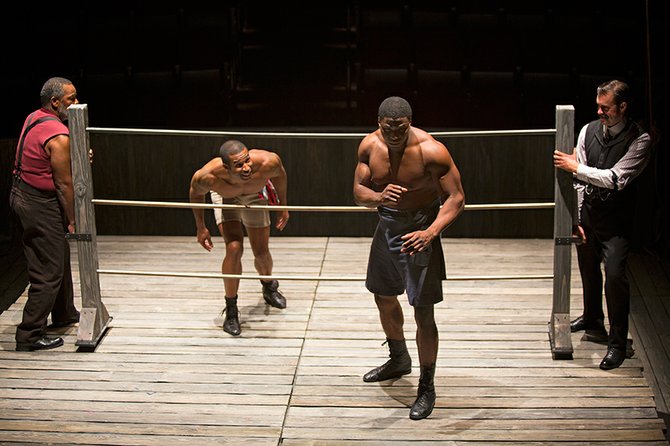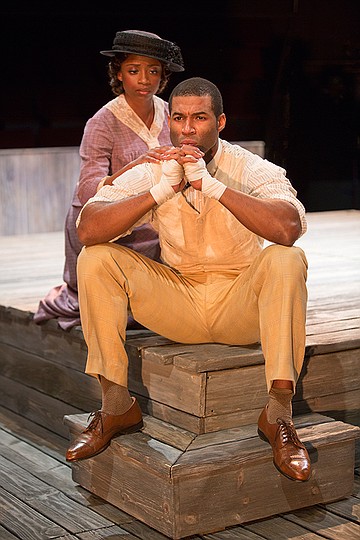 Facebook
Facebook
 X
X
 Instagram
Instagram
 TikTok
TikTok
 Youtube
Youtube

Take away the spectacular theatricality and Marco Ramirez’s The Royale would be a thin-ish script that makes some important points. The characters stand as much for a position in a debate as for themselves. But add the hands clapping in series’ of threes, often followed by a foot stomp and a “ha!”; and stylized boxing matches where lights flash, noises jolt, and you feel, rather than see, the blows; and elevated performances by a stand-out cast, and the play becomes the ritualized conjuration of an era we should never forget.
Like Barney Oldfield and Lincoln Beachey, Jack Johnson was one of America’s first superstars. Neither the stars, nor the country, knew quite to do about the phenomenon. Oldfield, Beachy and Johnson paid dearly for their acclaim but Johnson most of all.
He was an African-American who burned to be Heavyweight Boxing Champion of the World. For his first professional fight — against John “Must Have It” Lee — Johnson won $1.50. Even when the “Fight of the Century” came about, against James J. Jeffries in 1910, a majority of the purse went to the white man.
Just prior to the fight, the New York Times wrote: “If the black man wins, thousands and thousands of his ignorant brothers will misinterpret his victory as justifying claims to much more than mere physical equality with their white neighbors.”

Johnson won the fight. Jeffries said he “never could have whipped Johnson at my best.” And African-Americans across the country paid for the victory, many with their lives.
Jay “The Sport” Johnson (“he’s so good at the sport they call him 'The Sport'”) is and is not Jack Johnson. The play is “loosely based” on the original — and just as loose with the historical moment. The Royale says the “fight of the decade” was on radio in 39 states (while Johnson’s battle with Jeffries was in 1910, and radios didn’t go commercial until 1920-21). I doubt they f-bombed so readily back then. And, to my knowledge at least, the first boxer to use the expression “rope a dope” was the great Muhammad Ali.
Johnson is the “Negro Heavyweight Champ.” To unify the titles and become World Champion he must defeat retired Bernard Bixby. Now overweight, Bixby will do it for 90% of the purse.
Up to now, Royale follows the predictable rags to riches, Rocky I, II, III, etc. arc, enlivened by Johnson’s exuberant, trash-talking personality. Then his sister Nina enters. She’s obviously a vehicle for the author to tweak his themes. But as played by Montego Glover, and brilliantly staged by Rachel Chavkin, Nina’s clash with Johnson takes on far deeper resonances than expected. Theirs is the battle that takes place in the ring.
Written in six “rounds,” Royale has a jab-, counter-, and Sunday Punch-soundscape (Matt Hubbs, sound designer). The cast becomes a kind of percussion section, or walking bass line, punctuating the blows and driving the piece with an intense, game-day energy.
The cast is a 110%, fully-committed ensemble: Robert Christopher Riley’s epic Jay Johnson; Ray Anthony Thomas’s Wynton, the sage corner-man; Okieriete Onaodowan’s Fish (built like an NFL linebacker, vulnerable as a tear); John Lavelle’s Max (Johnson’s racist manager); and the excellent, insistent Glover.
Nicholas Vaughan’s set, wooden-slatted platform, wooden walls, turns the Sheryl and Harvey White Theatre into a prizefighter’s pit. Denitsa Bliznakova’s costumes (down to the appropriately high-topped, black-leather boxing shoes) capture the period, as does Austin R. Smith’s lighting, which includes light bulbs, with old-time, zig-zag filaments, over the house seats.


Take away the spectacular theatricality and Marco Ramirez’s The Royale would be a thin-ish script that makes some important points. The characters stand as much for a position in a debate as for themselves. But add the hands clapping in series’ of threes, often followed by a foot stomp and a “ha!”; and stylized boxing matches where lights flash, noises jolt, and you feel, rather than see, the blows; and elevated performances by a stand-out cast, and the play becomes the ritualized conjuration of an era we should never forget.
Like Barney Oldfield and Lincoln Beachey, Jack Johnson was one of America’s first superstars. Neither the stars, nor the country, knew quite to do about the phenomenon. Oldfield, Beachy and Johnson paid dearly for their acclaim but Johnson most of all.
He was an African-American who burned to be Heavyweight Boxing Champion of the World. For his first professional fight — against John “Must Have It” Lee — Johnson won $1.50. Even when the “Fight of the Century” came about, against James J. Jeffries in 1910, a majority of the purse went to the white man.
Just prior to the fight, the New York Times wrote: “If the black man wins, thousands and thousands of his ignorant brothers will misinterpret his victory as justifying claims to much more than mere physical equality with their white neighbors.”

Johnson won the fight. Jeffries said he “never could have whipped Johnson at my best.” And African-Americans across the country paid for the victory, many with their lives.
Jay “The Sport” Johnson (“he’s so good at the sport they call him 'The Sport'”) is and is not Jack Johnson. The play is “loosely based” on the original — and just as loose with the historical moment. The Royale says the “fight of the decade” was on radio in 39 states (while Johnson’s battle with Jeffries was in 1910, and radios didn’t go commercial until 1920-21). I doubt they f-bombed so readily back then. And, to my knowledge at least, the first boxer to use the expression “rope a dope” was the great Muhammad Ali.
Johnson is the “Negro Heavyweight Champ.” To unify the titles and become World Champion he must defeat retired Bernard Bixby. Now overweight, Bixby will do it for 90% of the purse.
Up to now, Royale follows the predictable rags to riches, Rocky I, II, III, etc. arc, enlivened by Johnson’s exuberant, trash-talking personality. Then his sister Nina enters. She’s obviously a vehicle for the author to tweak his themes. But as played by Montego Glover, and brilliantly staged by Rachel Chavkin, Nina’s clash with Johnson takes on far deeper resonances than expected. Theirs is the battle that takes place in the ring.
Written in six “rounds,” Royale has a jab-, counter-, and Sunday Punch-soundscape (Matt Hubbs, sound designer). The cast becomes a kind of percussion section, or walking bass line, punctuating the blows and driving the piece with an intense, game-day energy.
The cast is a 110%, fully-committed ensemble: Robert Christopher Riley’s epic Jay Johnson; Ray Anthony Thomas’s Wynton, the sage corner-man; Okieriete Onaodowan’s Fish (built like an NFL linebacker, vulnerable as a tear); John Lavelle’s Max (Johnson’s racist manager); and the excellent, insistent Glover.
Nicholas Vaughan’s set, wooden-slatted platform, wooden walls, turns the Sheryl and Harvey White Theatre into a prizefighter’s pit. Denitsa Bliznakova’s costumes (down to the appropriately high-topped, black-leather boxing shoes) capture the period, as does Austin R. Smith’s lighting, which includes light bulbs, with old-time, zig-zag filaments, over the house seats.
Comments